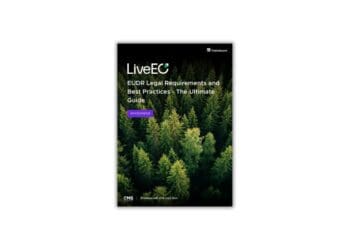Putting a new product or drug on the market in Europe may require jumping through a lot of regulatory hurdles to prove those products are safe. ESG columnist John Peiserich talks about how when developing robust sustainability goals, companies can incorporate information originally generated as part of product stewardship and drug approval obligations, using the heavy lifting of product launch to make ESG reporting easier.
The EU’s Registration, Evaluation, Authorisation and Restriction of Chemicals regulation (REACH) governs product stewardship, obligating companies to pass a variety of chemical safety assessments, while the European Medicines Agency (EMA) evaluates medicinal products for their potential risk to human health and the environment.
While some ESG reporting is mandatory in Europe, there is still not 100% alignment between company-established goals and ESG reporting. On the other hand, both EMA and REACH are nondiscretionary and well-defined.
Because of the flexibility of corporate sustainability goals, EMA and REACH can become functional components of sustainability. Companies, in identifying their sustainability goals, routinely include the reduction of environmental impacts of their products, improving resource efficiency, and promoting sustainable practices. These goals can be aligned with product stewardship efforts, including EMA and REACH obligations, to ensure that products are designed, produced, and disposed of in a sustainable manner.
Interplay of EMA and REACH
REACH aims to ensure the safe use of chemicals in the EU. It requires companies to register information on the properties and uses of chemicals they produce or import into the EU and to take steps to manage any risks associated with their use. REACH is primarily concerned with the safety of chemicals and their impact on human health and the environment.
EMA, on the other hand, is responsible for the scientific evaluation and regulation of medicinal products for human and veterinary use in the EU. It evaluates the safety, efficacy, and quality of medicinal products and makes recommendations on their authorization for use in the EU.
When a new drug is being developed, the advocating pharmaceutical company must provide data to both REACH and EMA. The company must register any chemical substances used in the drug with REACH, providing information on properties and potential risks. The company must also submit a dossier of data to EMA, which includes information on the safety, efficacy, and quality of the drug.
EMA may consult with REACH during the evaluation of a new drug to ensure that the chemicals used in the drug are safe for their intended use. EMA may also consider any restrictions on the use of the chemicals imposed by REACH when making a recommendation on the authorization of the drug. In addition, EMA and REACH may share information and collaborate on areas of mutual interest, such as the safe use of chemicals in medicinal products.
The information generated through REACH chemical safety assessments (CSAs), EMA approvals and related toxicological assessments are excellent metrics for sustainability. Lifecycle assessments (LCAs), for example, can be used to identify improvement opportunities, create metrics for tracking and analysis and drive improvements to environmental impacts. Those same LCAs can be used to inform product design and development, which subsequently reduces product stewardship costs and reflects how sustainability efforts should also include a profit consideration. It is helpful to remember that sustainability is the management of three “Ps” — people, planet and profit.
GHG Verification an Overlooked Board Responsibility?
Organizational buy-in of sustainability goals must go all the way to the top, including the board of directors, if those goals have any hope of being met. As ESG columnist John Peiserich explores, there are some nuances board directors should be aware of regarding greenhouse gas emissions.
Read moreDetailsProduct stewardship and REACH
REACH establishes procedures for collecting and assessing information on the properties and hazards of substances used by various companies across many sectors within the European Union. The candidate list of substances of very high concern (SVHCs) for authorization under the REACH regulation is a major initiative for the development and transition to less hazardous chemical use by companies striving for sustainability. A study on the socioeconomic impacts of REACH authorization conducted by the European Chemicals Agency (ECHA) found the authorization requirement resulted in many companies reducing their use of SVHCs and seeking safe and sustainable alternatives. In addition, the European Commission adopted its Chemicals Strategy for Sustainability in 2020 in which its goal was to create a “toxic-free environment” by driving innovation toward safer and more sustainable alternatives. It aims to “better protect citizens and the environment” and “boost innovation for safe and sustainable chemicals.”
The specifics of the strategy include 1) banning the use of “the most harmful chemicals” (such as carcinogens, mutagens, reproductive toxicants, endocrine disruptors and persistent and bioaccumulative chemicals) in consumer products and only allow their use if it is essential; 2) phasing out the use of per- and polyfluoroalkyl substances (PFAS) in the EU unless their use is essential; and 3) promoting the EU’s supply and sustainability of “critical chemicals” (such as raw materials, intermediates or active pharmaceutical ingredients used to produce pharmaceuticals). The strategy is part of the European Commission’s Green Deal for zero pollution.
Product stewardship and EMA
EMA has scientific guidelines on the environmental risk assessment (ERA) report that accompanies the marketing authorization application for human medicinal products. The guideline describes how companies should assess the potential risks of their human medicinal products to the environment from use, storage and disposal based on their respective environmental bioaccumulation and persistence potential. Emissions into the environment from the manufacturing or production of pharmaceuticals are not covered. The EMA published a draft revision of its ERA guideline in 2018 but a finalized copy has not been released at present.
Sustainable products
There is growing interest in sustainable product design, which seeks to minimize the environmental impact of products throughout the product lifecycle. Toxicologists should consider how products can be designed to reduce toxicity and environmental impact, as there is a growing opportunity to contribute to corporate sustainability goals. This could include advice regarding the use of safer chemicals, reducing packaging, designing products to facilitate repair and recycling and improving waste management options to reduce environmental impact.
One of the well-managed sustainability programs we have an opportunity to work with starts with a baseline assumption: “Do no harm.” In discussions with the corporate leadership about the program, “do no harm” just made sense to them. It was clear from the boardroom to the production floor exactly what the expectation was for every company activity.
Clarity is critical if sustainability is to permeate day to day operations. “Do no harm” fulfills all three “Ps” and sets a floor for improvements. Perhaps more importantly, it gives the people within the company a good sense of purpose and a bit of comfort as they conduct day-to-day operations with that focus. Sustainable products (“do no harm” products) meet those same three “Ps” — no harm to people, no harm to planet and no harm to the company profits.
Sustainable products, those that result from strong product stewardship programs, drive profits. By marketing sustainability, companies benefit through increased share, pricing premiums and reputational advancement. All three serve to drive profits. Sustainable value chains and operations improve resource management and reduce environmental costs/impacts which improve profits. Similarly, sustainable products are highly sought in the marketplace and provide an avenue for growth.
In the “people” component, good products are better received by the consumer and build pride in the company workforce. Remember, REACH makes chemical data publicly available and facilitates public comment and review of that data (think NGOs). That process promotes public trust in products as a result. EMA follows a similar public review which promotes public trust in medicinal products. These regulatory processes have a positive impact on the people component in numerous ways.
Those same products do no harm to the planet, resulting in fewer costs through their lifecycle. In combination, profits are better when costs are lower and sales are higher. Higher profits mean better reception in the overall marketplace and better access to capital. An appropriate sustainable product strategy flows into overall better corporate performance.
Steps to leverage product stewardship for sustainability goals
During the development of corporate sustainability goals, even before materiality determinations have been made, it is important to include product stewardship program information in the development discussion. Because product stewardship provides measurable data, the inclusion in the overall corporate sustainability goals can make the sustainability program more robust, more data driven and more impactful. ESG reporting, particularly when departing from climate-driven reporting, tends to lack numerical drivers and relies more on soft science.
First, develop a compliant product stewardship program. With strategies to minimize the environmental impact of products throughout their lifecycle, product stewardship programs are ideal components of overall corporate sustainability programs. Second, identify components within the product stewardship program that fit your company’s overall sustainability goals and repurpose those components with a view toward sustainability metrics. Third, remember that EMA, REACH and related regulatory programs include stakeholder engagement obligations. Inputs from stakeholders are just as important in sustainability programs as product stewardship. Be sure to leverage good stakeholder engagement across both platforms. Finally, develop a reporting framework to track all these components. Systems such as the Global Reporting Initiative (GRI) or the Sustainability Accounting Standards Board (SASB) provide excellent frameworks for reporting on sustainability performance.
Plug-and-play opportunities for sustainability from existing product stewardship efforts
Regulation mandated environmental risk assessments (ERAs) can identify potential risks to the environment, such as the toxicity to aquatic organisms or the potential for antibiotics to promote antimicrobial resistance. ERAs can help identify and mitigate potential environmental risks. ERAs can be leveraged into existing sustainability programs to reflect the efforts made to reduce impacts to the environment. For sustainability purposes, these create a good reportable data set for the company that can be tracked and reported on with substantial backup data.
Leverage regulatory-driven stakeholder engagements. Open lines of communication with regulatory agencies, shareholders, NGOs and other stakeholders create opportunities to tell the “do no harm” sustainability story. Establishing “do no harm” as the expectation on both sides of any discussion will lead to better and more sustainable results. One of my author’s colleagues describes the sustainability process as “being better” as a result of sustainability efforts. Stakeholders appreciate open lines of communication, and companies benefit tremendously in reputational gains as a result.




 John Peiserich is a senior vice president in J.S. Held’s Environmental, Health & Safety — Risk & Compliance group. With over 30 years of experience, John provides consulting and expert services for heavy industry and law firms throughout the country with a focus on oil and gas, energy and public utilities. He has extensive experience evaluating risk associated with potential and ongoing compliance obligations, developing strategies around those obligations, and working to implement a client-focused compliance strategy. He has appointments as an independent monitor through EPA’s Suspension and Debarment Program. John routinely supports clients in a forward-facing role for rulemaking and legislative issues involving energy, environmental, oil and gas, and related issues.
John Peiserich is a senior vice president in J.S. Held’s Environmental, Health & Safety — Risk & Compliance group. With over 30 years of experience, John provides consulting and expert services for heavy industry and law firms throughout the country with a focus on oil and gas, energy and public utilities. He has extensive experience evaluating risk associated with potential and ongoing compliance obligations, developing strategies around those obligations, and working to implement a client-focused compliance strategy. He has appointments as an independent monitor through EPA’s Suspension and Debarment Program. John routinely supports clients in a forward-facing role for rulemaking and legislative issues involving energy, environmental, oil and gas, and related issues. 








